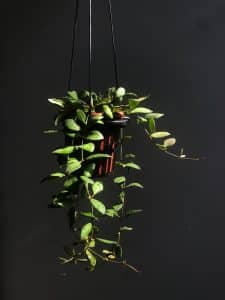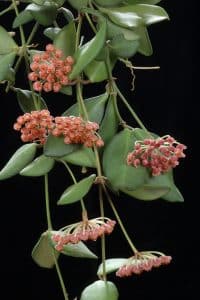Whether you currently have hoyas in your home and aren’t sure about their species or trying to decide on the best-fit hoya to buy, understanding the difference between the hoya burtoniae and bilobata is essential.
Read on to discover the similarities and differences hoya burtoniae vs. bilobata, which belong to the milkweed family.
What Is Hoya Burtoniae?
The hoya burtoniae is a relatively uncommon but very much beloved hoya species. In fact, it wasn’t even until 1990 that scientists discovered this plant.
Hoya burtoniaes have a hardiness zone of 10 to 12. For this reason, it’s common to find people growing it indoors in cooler regions. But even those living in warmer climates enjoy having this tropical plant inside.
Caring for the hoya burtoniae is easy, given that this plant has few maintenance requirements.
You should place hoya burtoniaes in an area with lots of access to indirect sunlight. They need well-draining and well-aerated soil, and you don’t have to worry about them dying out if you forget to water them. Too much water can kill them.
What Is Hoya Bilobata?
The hoya bilobata has a higher tolerance for cooler temperatures than the burtoniae, with a hardiness zone of 8 to 11. It’s also had more time to make it into people’s homes, given that it’s been on the human radar since 1906.
Like the hoya burtoniae, the bilobata doesn’t do well with too much water. When in doubt, it’s best to underwater rather than overwater this plant, although letting the soil completely dry out will ultimately lead it to wither.
You should also place the hoya burtoniae in indirect light. It isn’t common for disease or pests to plague this plant; too much water is the biggest reason for its demise in homes.
Compared to the hoya burtoniae, the bilobata does well with extra fertilizer.
Similarities Between Hoya Burtoniae and Bilobata
Although there are more differences than similarities between the hoya burtoniae and bilobata, below are some of the features they share:
- Needs infrequent watering
- Requires indirect sunlight
- Thrives in warm climates
- Excellent indoor plants
- Flowers grow in clusters
- Leaves are the main attraction
- Easy to propagate
The bottom line is that if you can take care of a hoya burtoniae, you’ll be able to care for a hoya bilobata and vice versa.
Homeowners also welcome these plants for their bold, beautiful leaves that remain good year-round. You can also propagate either of these plants via stem cuttings or separation. They’re prolific growers, and propagated hoyas make excellent gifts.
Differences Between Hoya Burtoniae and Bilobata
Despite sharing the same family and genius, there are significant differences between the hoya burtoniae and bilobata, making it easy to tell them apart. Below are some of their most notable differences:
- Burtoniae grows taller
- Bilobata has smaller and more varied leaves
- Burtoniae has fuzzy leaves
- Bilobata has smooth leaves
- Burtoniae doesn’t have branched stems
- Bilobata has twinning vines
- Burtoniae has a yellow flower
- Bilobata has a pink flower
Hoya bilobatas grow less than two feet long compared to Burtoniaes, which can grow up to six feet. Whereas the burtoniae has strictly ovate leaves, the leaves on bilobatas can come in shapes like oval, round, elliptic, and more.
Naturally, given their larger size, hoya burtoniaes also grow larger flowers and leaves. Kids will delight in these plants, as they have fuzz on their leaves.
Although the base of the hoya bilobata and burtoniae flowers have pink and yellow flowers, respectively, they also have different colored centers. For example, the hoya bilobata has a dark pink or orange color in the center of the flower, whereas the burtoniae has a dark pink color that almost teeters on red.
We already established that both of these flowers come in clusters. However, the burtoniae’s flower clusters are significantly larger than the bilobata’s, which only grow one to two inches in diameter.
The hoya burtoniae’s flowers also have a waxier texture than the hoya bilobata.
Which Hoya Will You Choose?
Hundreds of hoyas exist, and hoya burtoniae vs. bilobata are among a handful of the favorites among homeowners.
These plants are an excellent fit for beginner gardeners who want a low-maintenance plant to keep inside their house or outside in their garden if they live in a warm enough climate. There are many other varieties of hoya including the hoya tricolor and Krimson queen.

